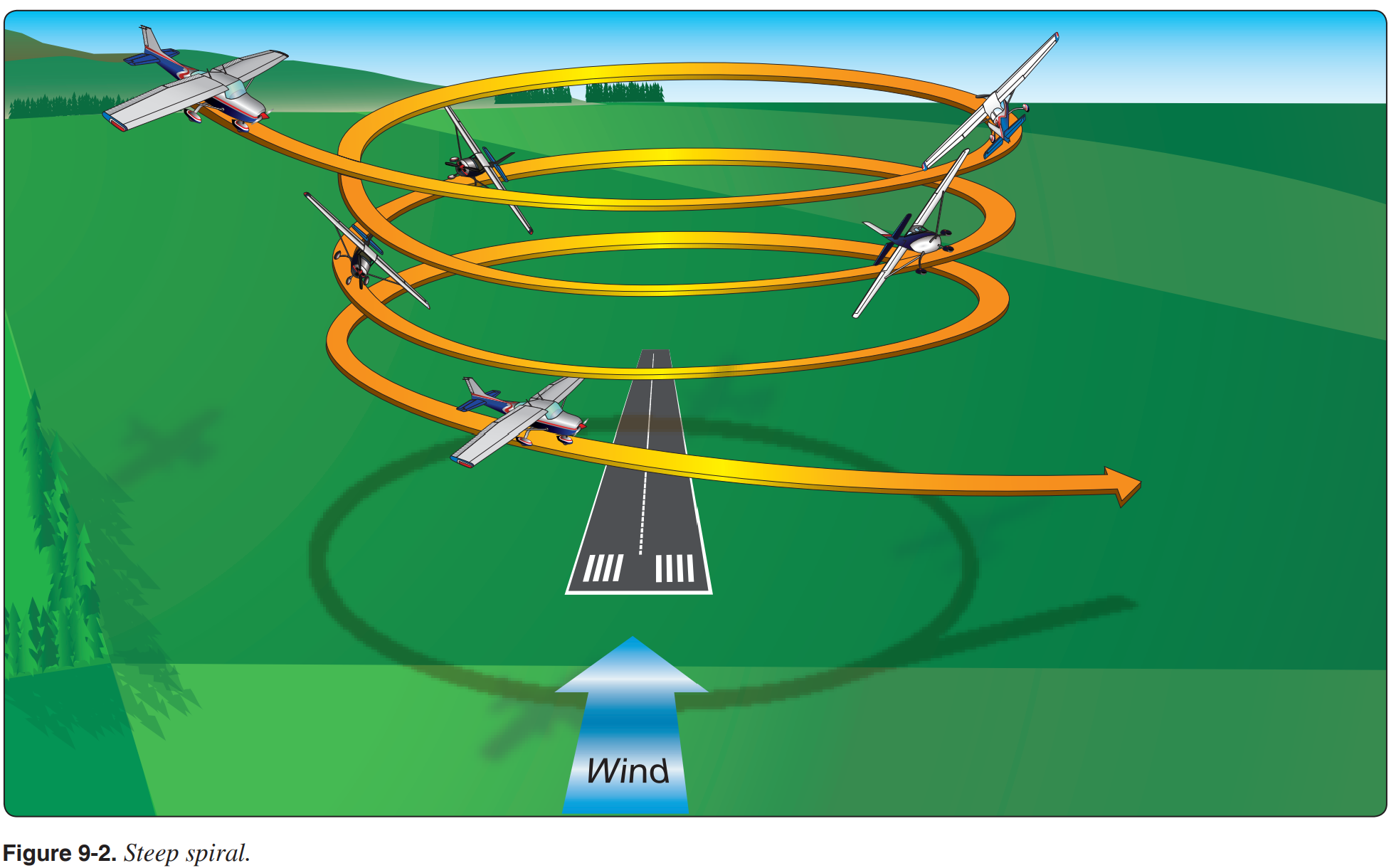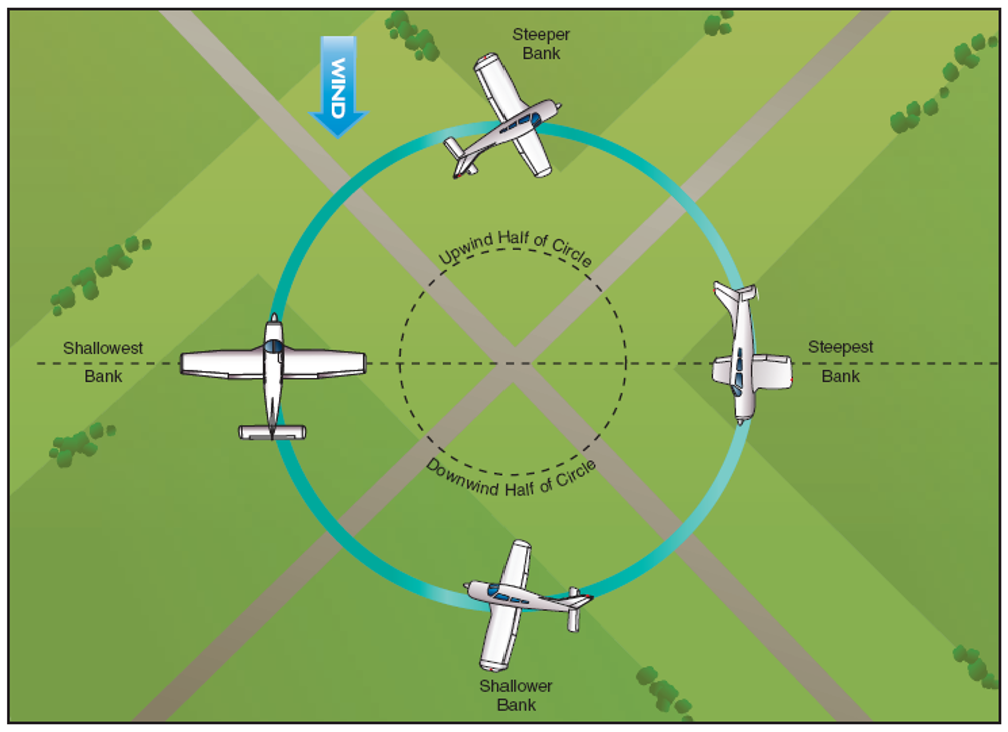Task IX.B: Steep Spirals
Lesson Overview
- Objective
-
The student should be able to perform the steep spiral maneuver to ACS/PTS standards adjusting for varying wind speed and direction as well as changing bank angles.
- Reference
-
-
Aircraft Flight Manual / Pilot’s Operating Handbook
-
Airplane Flying Handbook
-
- Key Elements
-
-
Similar to Turns Around a Point
-
Increased groundspeed = Increased Bank
-
Decreased Groundspeed = Decreased Bank
-
Keep the reference between the wing root and fuselage
-
Elements
-
The Science Behind It
-
Performing the Steep Turn
Equipment
-
White board and markers
-
References
-
iPad
Instructor Actions
-
Discuss lesson objectives
-
Present Lecture
-
Ask and Answer Questions
-
Assign homework
Student Actions
-
Participate in discussion
-
Take notes
-
Ask and respond to questions
Schedule
-
Discuss Objectives
-
Review material
-
Development
-
Conclusion
Completion Standards
The student understands the elements involved in a properly flown steep spiral. The student can apply those elements to a well flown, coordinated steep spiral.
Instructor Notes
- Attention
-
This can be a really cool maneuver, especially when combined with a power off 180° landing. The ability to maintain a position over the ground, while descending (as in an emergency landing) makes for a much more confident pilot.
- Overview
-
Review Objectives and Elements/Key ideas
- What
-
A steep spiral is a constant gliding turn, during which a constant radius around a point on the ground is maintained similar to the turn around a point maneuver.
- Why
-
The steep spiral improves pilot techniques for airspeed control, wind drift control, planning, orientation, and division of attention. The steep spiral is not only a valuable flight training maneuver, but it has practical application in providing a procedure for dissipating altitude while remaining over a selected spot in preparation for landing, especially for emergency forced landings.
Lesson Details
In a steep spiral the pilot must maintain an equal radius turn around a point. The radius should be approximately 1/4 mile, and be such that the steepest bank never exceeds 60° of bank. As in the usual turns around a point maneuver the pilot must adjust for headwinds and tailwinds. To maintain the consistent radius circle the bank angle is increased as groundspeed increases, and is decreased as groundspeed decreases.
The maneuver requires that it be entered on the downwind side, which will establish the steepest bank since groundspeed is highest at this point. This also helps to establish the radius to be used.
The spiral should be continued through three consecutive 360° spirals. The maneuver should be started at an altitude such that it would not be continued any lower than 1,500 feet AGL (unless performing an emergency landing in conjunction with the spiral). Clear the engine periodically to avoid excessive engine cooling or fouling. Doing so while facing into the wind minimizes any variation in the aircraft groundspeed and radius of turn.
Rules
-
Maintain an equal radius of turn around a point
-
Bank angle is increased as groundspeed increases and decreased as groundspeed decreases to maintain a consistent radius
-
Enter on the downwind
-
The spiral should be continued through three 360 degree spirals
-
Clear the engine periodically while headed into the wind
-
Operating at idle for a prolonged period of time may result in excessive engine cooling or spark plug fouling
-
Clearing while facing into the wind minimizes any variation in groundspeed and radius of turn
-
Performing a Steep Spiral

Before Starting
-
First perform the pre-maneuver checklist
-
Fuel Pump - ON
-
Mixture - RICH
-
Lights - ON
-
Gauges - GREEN
-
-
Ensure that the area is clear of traffic below, above, and at your altitude.
-
Ensure that the aircraft has sufficient altitude before starting the maneuver.
-
Enough altitude to perform three 360° turns and terminate above 1,500 feet AGL. This is usually no lower than 4,000 feet AGL.
-
-
Select a ground reference point.
-
It can be a house, tower, but should ideally be selected in a sparsely populated area with surrounding terrain that would permit an emergency landing.
-
-
Set up the maneuver on the downwind.
-
Position the aircraft so that it will pass within 1/4 mile of the reference point.
Entering the Spiral
-
Close the throttle and establish the recommended entry airspeed
-
Trim the plane for the desired airspeed
-
-
Start a gliding spiral and maintain a constant radius around the reference point
-
Upon rolling in, put the reference point between the wing tip and the fuselage.
During the Spiral
-
Keep the reference point at a consistent position with respect to the aircraft to maintain the correct radius.
-
During the descending spiral the pilot just judge the direction and speed of the wind at different altitudes and make appropriate changes in the angle of bank to maintain a uniform radius.
-
Make bank angle corrections when flying between a headwind and a tailwind. As the aircraft descends wind direction may, and usually does, change. Adjustments will be required.
-
-
Since the pilot enters with a tailwind (downwind) bank should be increased to maintain a constant radius.
-
The faster the ground speed the steeper the bank.
-
-
When tracking into a headwind the bank must be decreased.
-
The slower the groundspeed the shallower the bank.
-
-
Think turn radius, where "higher speed == greater radius"
-
Also maintain pitch attitude between the varying bank angles to provide for a stabilized descent.
-
Failure to hold airspeed constant will cause the radius of the turn and the necessary angle of bank to vary excessively.
-
-
In contrast to turns about a point, the pilot must vary pitch attitude to maintain a constant airspeed throughout the entire maneuver.
-
Continually divide attention between the ground reference point and instruments to ensure that ground track, airspeed, and altitude are correct.
-
Check the amount of altitude lost during each turn. This will establish the last 360 and the entry into the pattern 'downwind' for an emergency landing.
-
Rolling out of the Turn

After completing three turns, roll out within 10° of the entry heading
During the rollout smoothness is essential and the use of controls must be so coordinate that no increase or decrease in airspeed results then the straight glide is resumed.
Common Errors
-
Improper pitch, bank, and power coordination during entry or completion
-
Uncoordinated use of flight controls
-
Improper planning and lack of maintenance of constant airspeed and radius
-
Failure to stay orientated to the number of turns and the rollout heading
Conclusion
The steep spiral is just like a turn around a point with the addition of a constant speed descent. The same procedures apply with the addition of making adjustments to the pitch attitude to maintain 83 knots. It is important to stay oriented in relation to the number of turns you have made and the entry and rollout heading as it is easy to get confused.
ACS Requirements
CFI PTS Standards
- To determine that the applicant
-
-
Exhibits instructional knowledge of the elements of steep spirals by describing:
-
The purpose of steep spirals and their relationship to emergency landing procedures.
-
Selection of entry altitude.
-
Entry airspeed and power setting.
-
Selection of a proper ground reference point.
-
Division of attention and planning.
-
Coordination of flight controls.
-
Maintenance of constant radius around selected point.
-
Maintenance of constant airspeed throughout maneuver.
-
-
Exhibits instructional knowledge of common errors related to steep spiral by describing:
-
Improper pitch, bank, yaw, and power coordination during entry or completion.
-
Uncoordinated use of flight controls.
-
Improper planning and lack of maintenance of constant airspeed and radius.
-
Failure to stay orientated to the number of turns and the rollout heading.
-
-
Demonstrates and simultaneously explains a steep spiral from an instructional standpoint.
-
Analyzes and corrects simulated common errors related to steep spirals.
-
Commercial Pilot ACS Skills Standards
-
Clear the area.
-
Select an altitude sufficient to continue through a series of at least three 360° turns.
-
Establish and maintain a steep spiral, not to exceed 60° angle of bank, to maintain a constant radius about a suitable ground reference point.
-
Apply wind drift correction to track a constant radius circle around selected reference point with bank not to exceed 60° at steepest point in turn.
-
Divide attention between airplane control and ground track, while maintaining coordinated flight.
-
Maintain the specified airspeed, ±10 knots, rolls out toward object or specified heading, ±10°.